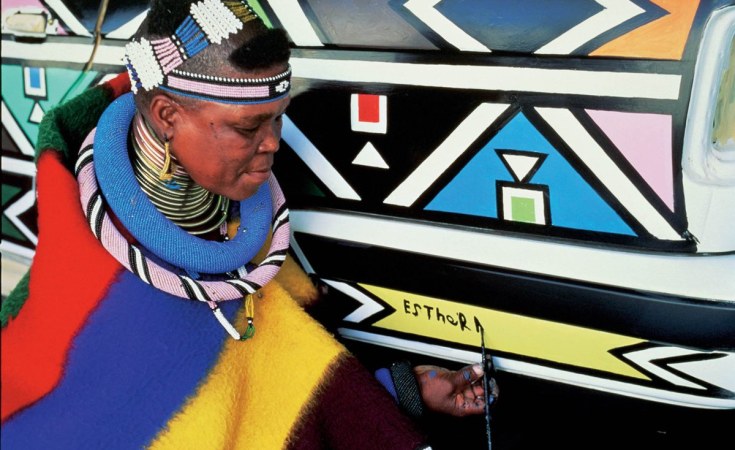Esther Mahlangu is having a retrospective of her world famous art in Cape Town. Now 88, the South African visual artist is best known for her colourful large-scale murals in the traditional patterns and colours of the Ndebele people of South Africa - once famously displayed on a BMW as part of a global advertising campaign. But how is she regarded by her people and what does her work represent? We asked Sifiso Ndlovu, an expert in the art and identity of the Ndebele people, to tell us more.
Who is Esther Mahlangu?
Esther Nostokana Mahlangu was born on 11 November 1935 in the Middelburg area of South Africa's mostly rural Mpumalanga province. Today she lives in Mthambothini village, a few hours away.
Mahlangu didn't attend any formal schooling but her vibrant and distinctive artwork has earned her honorary doctorates and luminary status in contemporary African arts both locally and internationally. She grew up watching elders like her grandmothers doing wall paintings in the homestead and began to imitate them. She practised over and over until she had learned to master the art of producing patterned Ndebele ornamentation.
Her work was first picked up by the Botshabelo open air museum in Middelburg, where she showcased her wall paintings. She attracted international interest from a team of French researchers in 1989. They invited her to France to take part in a project to paint the halls of the famous Centre Pompidou gallery in Paris. Her first-ever trip in an aeroplane was to became a pivotal moment that would lead to trips across the world, to Japan, Portugal, the US, New Zealand, Italy, Spain... Today Mahlangu is regarded as the global face of Southern Ndebele material culture.
Her artworks are an expression of Ndebele-ness through which identity is preserved, maintained and continued across space and time.
How do the Ndebele use wall paintings to express identity?
For hundreds of years the Ndebele people have used architecture, mural painting and beadwork to express that they belong to a distinctive identity. This material culture became particularly important as they began to become dispersed - starting in the 1800s with war against the colonial boers and heightened in the 1940s by the onset of apartheid and white minority rule in South Africa.
As they lost their land and became dispersed, Ndebeles held on to their painting, architecture and beaded dress to help preserve their sense of belonging and identity. They continued to paint their homes and maintain architectural designs as a way of expressing who they were and defending the loss of their identity. Their material culture has evolved to express cultural resistance and continuity.
Wall paintings were mostly used to express Ndebele values, marriage and other everyday expressions of identity such as women's role in the domestic space. Paintings were mainly done by women and they reflect gender roles in the community. Through their paintings women were made socially visible and came to be seen as guardians through which Ndebele identity was maintained across generations. This was especially in the absence of men, who were largely pushed out to find migrant work as farm labourers or in the cities.
At first, in order to make red, black and white paint, clay was mixed with cow dung and soil. Today acrylic paint is mixed with a little bit of clay and the designs now include complicated geometric patterns combined with illustrations of objects like light bulbs and aeroplanes.
What about the beadwork?
Mahlangu also uses dress to display her cultural identity. She always dresses in the beaded blankets commonly worn by Ndebele women. Her beads reflect her age and marital status. This is extended to her bracelets and haircuts.
Some beaded adornments are only worn on special social occasions - like welcoming initiates when they come back home from initiation schools. Age-sets and stages of growth from childhood to adulthood are expressed through different kinds and colours of beaded adornments.
Beadwork or painting is passed on to each generation and becomes a conduit for the preservation and transmission of Ndebele cultural identity. Thanks to a figure like Mahlangu, this material culture is made all the more visible in the digital age.
How does she develop tradition and also experiment with it?
Mahlangu changed from the use of natural colours to brighter, acrylic paints. While staying true to Ndebele traditions, she is not scared to experiment. In her work she has used, for example, the colours of the democratic-era South African flag, which is a popular part of the country's nation-building project. Even though she uses modern acrylic paints, she still mixes them with clay in the old way.
She also engages with modern technology and the commercial art world. In 1991, for example, she was commisssioned by BMW to paint one of their international art cars. This was again because of her Botshabelo museum exhibition. She was invited to Johannesburg to paint the car, which she did over a period of two weeks using chicken feathers.
Read more: Madosini, a South African national treasure whose music kept a rich history alive
Between prestigious gallery exhibitions and public art commissions, she creates diverse products from her work. She sells coffee cups, decor pots, beaded blankets and photographs of her mural art.
And she also teaches. As a custodian of Ndebele culture she teaches young boys and girls to do wall paintings, beadwork and traditional Ndebele dances in the backyard of her homestead in Mpumalanga. She has never wavered from her commitment to preserving Ndebele culture and passing it on.
Sifiso Ndlovu, Lecturer of Political Science, University of Mpumalanga


